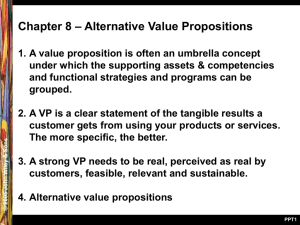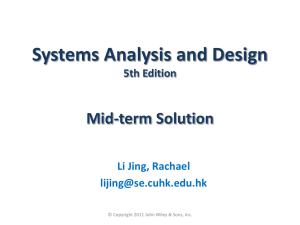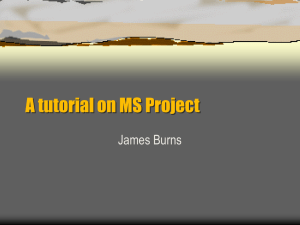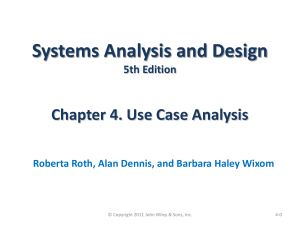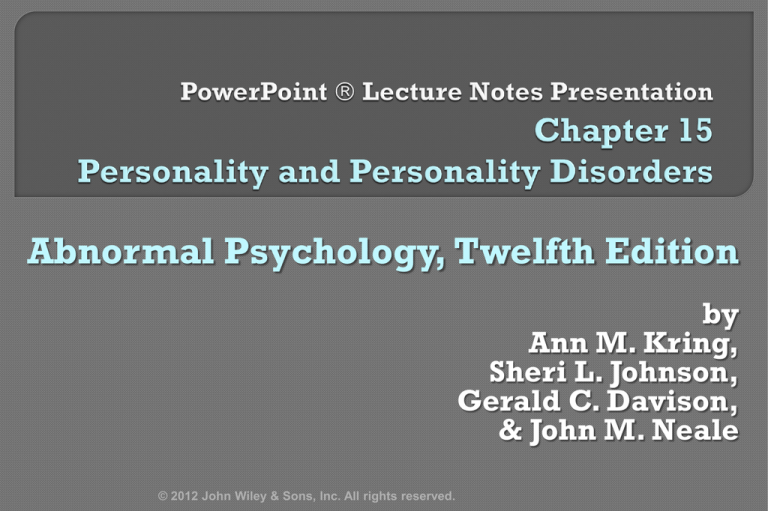
Abnormal Psychology, Twelfth Edition
by
Ann M. Kring,
Sheri L. Johnson,
Gerald C. Davison,
& John M. Neale
© 2012 John Wiley & Sons, Inc. All rights reserved.
Chapter
15: Personality and Personality
Disorders
I. Comparing Personality Assessment in
the DSM-IV-TR and the Proposed DSM-5
II. Personality Disorder Types
III. Treatment of Personality Disorders
Copyright © 2012 John Wiley & Sons, Inc. All rights reserved.
Longstanding, pervasive, inflexible, extreme, and persistent
patterns of behavior and inner experience
• Unstable positive sense of self
• Unable to sustain close relationships
Profound changes in personality diagnoses from DSM-IV-TR to
DSM-5
• 10 diagnoses in DSM-IV-TR; 6 diagnoses in DSM-5
• DSM-5 includes personality trait dimensions
Reasons for changes:
• Half who met diagnostic criteria for one DSM-IV-TR personality disorder met
•
•
•
•
diagnostic criteria for another personality disorder
Some of the DSM-IV-TR personality diagnoses are rare (< 2%)
Many people who seem to have serious personality problems do not fit any of the
personality disorder diagnoses
Individuals with a personality disorder can vary a good deal from one another in
the nature of their personality traits and the severity of their condition
To capture subsyndromal symptoms better
© 2012 John Wiley & Sons, Inc. All rights reserved.
© 2012 John Wiley & Sons, Inc. All rights reserved.
© 2012 John Wiley & Sons, Inc. All rights reserved.
© 2012 John Wiley & Sons, Inc. All rights reserved.
DSM-5
adds dimensional personality trait
dimension to familiar diagnostic approach
• Dimensional personality traits related to many aspects of
psychological adjustment, physical outcomes, and
interpersonal outcomes
DSM-5
includes four types of personality
ratings:
• Levels of personality functioning scale
• Six personality disorder types
• Five personality trait domain ratings as well as 25 facet
ratings to describe the more specific dimensions within
each of the five domains
• Criteria for a personality disorder
© 2012 John Wiley & Sons, Inc. All rights reserved.
© 2012 John Wiley & Sons, Inc. All rights reserved.
Two
broad areas of impairment related to
personality disorders:
• Disturbances in one’s sense of self or identity
• Chronic interpersonal disturbances
Rating
scale created for self and
interpersonal functioning
© 2012 John Wiley & Sons, Inc. All rights reserved.
Self:
• Identity: Experience of oneself as unique, with clear boundaries between self
and others; stability of self-esteem and accuracy of self-appraisal; capacity
for, and ability to regulate, a range of emotional experience
• Self-direction: Pursuit of coherent and meaningful short-term and life goals;
utilization of constructive and prosocial internal standards of behavior; ability
to self-reflect productively
Interpersonal:
• Empathy: Comprehension and appreciation of others’ experiences and
motivations; tolerance of differing perspectives; understanding of the effects
of own behavior on others
• Intimacy: Depth and duration of positive connections with others; desire and
capacity for closeness; mutuality of regard reflected in interpersonal
behavior
Rate the overall degree of impairment in self and interpersonal functioning:
• 0 No impairment
• 1 Mild impairment
• 2 Moderate impairment
• 3 Serious impairment
• 4 Extreme impairment
© 2012 John Wiley & Sons, Inc. All rights reserved.
If moderate impairment is present on Levels of Personality
Functioning Scale, next step is to evaluate for DSM-5
personality disorder types
• Personality disorder, ‘trait specified’ is used, and then the specific
maladaptive trait is noted, when no personality disorder matches
e.g., Personality disorder, high paranoia
DSM-5 uses prototype approach
• Person matched on a scale of 1 (no match) to 5 (very good match)
• Prototypes supplemented with personality domains and facets
DSM-5 has adapted the Five-Factor Model of Personality
• 5 personality domains: negative affectivity, detachment, antagonism,
disinhibition, psychoticism
• Each domain (factor) is comprised of multiple facets; total of 25 facets
© 2012 John Wiley & Sons, Inc. All rights reserved.
© 2012 John Wiley & Sons, Inc. All rights reserved.
Significant
impairments in self and
interpersonal functioning
At least one pathological personality trait
domain or facet
The personality impairments are stable across
time (persistent) and pervasive (consistent
across situations)
The personality impairments are not
explained by developmental stage, sociocultural environment, substance abuse,
another psychological condition, or a medical
condition
© 2012 John Wiley & Sons, Inc. All rights reserved.
A perfectionist
Preoccupied with rules, details, schedules, and
organization
Overly focused on work
• Little time for leisure, family, & friends
Reluctant to make decisions or delegate
“Control freaks”
• Rigid and inflexible, especially morality
OCPD different from OCD
• Does not have the obsessions/compulsions of OCD
Most frequently comorbid with Avoidant PD
Very little research into etiology
© 2012 John Wiley & Sons, Inc. All rights reserved.
Intense need for order and control, as shown by the
presence of at least four of the following beginning by
early adulthood and evidenced in many contexts:
• Preoccupation with rules, details, and organization to the extent
•
•
•
•
•
•
•
that the point of an activity is lost
Extreme perfectionism interferes with task completion
Excessive devotion to work to the exclusion of leisure and
friendships
Inflexibility about morals and values
Difficulty discarding worthless items
Reluctance to delegate unless others conform to one’s standards
Miserliness
Rigidity and stubbornness
© 2012 John Wiley & Sons, Inc. All rights reserved.
Need
for order, precision, and perfection
Activities approached in super-methodical and
overly detailed way
Intense concerns with time and rules
Overdeveloped sense of duty and obligation
Perfectionism may result in a paralysis of
indecision
Strong emotions (both negative and positive) are
rarely expressed
Intermittent insecurity and anxiety over
perceived deficiencies
© 2012 John Wiley & Sons, Inc. All rights reserved.
Pathological
personality traits in the following
domains and facets:
1. Compulsivity, characterized by rigid
perfectionism
2. Negative affectivity, characterized
by perseveration
Note: Facets are printed in blue
© 2012 John Wiley & Sons, Inc. All rights reserved.
Grandiose
view of self
• Preoccupied with fantasies of success
Self-centered
• Demands constant attention and adulation
• Lack of empathy
• Feelings of arrogance, envy, entitlement
Sensitive to criticism
• Enraged when not admired
Seeks out high-status partners
Most
frequently comorbid with Borderline PD
© 2012 John Wiley & Sons, Inc. All rights reserved.
Presence
of five or more of the following
shown by early adulthood in many contexts:
• Grandiose view of one’s importance
• Preoccupation with one’s success, brilliance, beauty
• Belief that one is special and can be understood only
•
•
•
•
•
by other high-status people
Extreme need for admiration
Tendency to exploit others
Lack of empathy
Envious of others
Arrogant behavior or attitudes
© 2012 John Wiley & Sons, Inc. All rights reserved.
© 2012 John Wiley & Sons, Inc. All rights reserved.
Kohut’s Self-Psychology Model
• Characteristics mask low self-esteem
• In childhood, narcissist valued as a means to increase
parent’s own self-esteem
Not valued for his or her own competency and self worth
• Parental emotional coldness and overemphasis on
child’s achievements reported by narcissists
Social cognitive model
• Narcissist has low self-esteem
• Interpersonal relationships are a way to bolster sagging self-
esteem rather than increase closeness to others
• Lab studies reveal cognitive biases that maintain narcissism
© 2012 John Wiley & Sons, Inc. All rights reserved.
Unusual and eccentric thoughts and behaviors
(psychoticism), interpersonal detachment, and
suspiciousness
Odd beliefs or magical thinking
• Telepathic, clairvoyant, ideas of reference
Illusions
• Feels the presence of a force or person not actually present
Odd/eccentric behavior or appearance
• Wears strange clothes
• Talks to self
Affect is flat; aloof from others
© 2012 John Wiley & Sons, Inc. All rights reserved.
Similar
to schizophrenia
• Individuals with schizotypal PD show problems
similar to those found in schizophrenia
Highly heritable (~60%)
Cognitive and neuropsychological deficits
Enlarged ventricles
Less temporal gray matter
© 2012 John Wiley & Sons, Inc. All rights reserved.
Presence of five or more of the following in many
contexts beginning in early adulthood:
• Ideas of reference
• Peculiar beliefs or magical thinking, e.g., belief in
•
•
•
•
•
•
•
extrasensory perception
Unusual perceptions, e.g., distorted feelings about one’s
body
Peculiar patterns of thought and speech
Suspiciousness or paranoia
Inappropriate or restricted affect
Odd or eccentric behavior or appearance
Lack of close friends
Anxiety around other people that does not diminish with
familiarity
© 2012 John Wiley & Sons, Inc. All rights reserved.
Discomfort with and reduced capacity for interpersonal relationships
Few close friends or relationships
Anxiety even in familiar social situations, including perception of being
an outcast, feel disconnected from others, suspiciousness of others
Eccentric, odd, or peculiar appearance or manner
Vague, circumstantial, overly elaborate, impoverished, or otherwise
unusual speech
Limited range of emotions and inhibited emotional expression
Cognitive and perceptual distortions
Odd beliefs, such as belief in superstitions, clairvoyance, or telepathy
Perceptions of reality can become more unusual under stress
Symptoms such as pseudo-hallucinations, sensory illusions, overvalued
ideas, mild paranoid ideation, or transient psychotic episodes
© 2012 John Wiley & Sons, Inc. All rights reserved.
Pathological
personality traits in the following
domains and facets:
1.
2.
3.
Psychoticism, characterized by eccentricity, cognitive
and perceptual dysregulation, and unusual beliefs and
experiences
Detachment, characterized by restricted affectivity
and withdrawal
Negative Affectivity, characterized by suspiciousness
Note: Facets are printed in blue
© 2012 John Wiley & Sons, Inc. All rights reserved.
Fears
criticism, rejection or disapproval
Avoids interpersonal situations
Restrained and inhibited in interpersonal
situations
• Feelings of inadequacy, inferiority
Avoids
taking risks or trying new activities
• Does not want to risk embarrassment
High
comorbidity with social anxiety disorder
• Related to Japanese syndrome called taijin kyofusho
(taijin means “interpersonal” and kyofusho means “fear”)
High
comorbidity with major depression
© 2012 John Wiley & Sons, Inc. All rights reserved.
A pervasive pattern of social inhibition, feelings of
inadequacy, and hypersensitivity to criticism as shown
by four or more of the following starting in early
adulthood in many contexts:
• Avoidance of occupational activities that involve significant
•
•
•
•
•
•
interpersonal contact, because of fears of criticism or disapproval
Unwilling to get involved with people unless certain of being liked
Restrained in intimate relationships because of the fear of being
shamed or ridiculed
Preoccupation with being criticized or rejected
Inhibited in new interpersonal situations because of feelings of
inadequacy
Views self as socially inept or inferior
Unusually reluctant to try new activities because they may prove
embarrassing
© 2012 John Wiley & Sons, Inc. All rights reserved.
Negative sense of self and profound sense of inadequacy
Inhibition in establishing intimate interpersonal relationships
Feelings of being inadequate, inferior, socially inept, and
personally unappealing
Unrealistically high standards for themselves
May have a desire to be recognized by others as special and unique
Shyness and social avoidance
Preoccupation with being criticized or rejected by others
Reluctance to disclose personal information for fear of disapproval
or rejection
Few close friendships
Intimate relationships are avoided
Tendency to blame themselves for bad things that happen and to
find little pleasure in life’s activities
Emotionally inhibited
Difficulty expressing wishes, emotions, and impulses
May be passive and unassertive about pursuing personal goals
© 2012 John Wiley & Sons, Inc. All rights reserved.
Pathological
personality traits in the following
domains and facets:
1. Detachment, characterized by withdrawal, intimacy
avoidance, and anhedonia
2. Negative Affectivity, characterized by anxiousness
Note: Facets are printed in blue
© 2012 John Wiley & Sons, Inc. All rights reserved.
Pervasive
disregard for the rights of others
Pattern of irresponsible behaviors
• Poor work record, breaking laws, being irritable and physically
aggressive, defaulting on debts, being reckless and impulsive,
neglecting to plan ahead, little regard for truth, and little remorse
for their misdeeds
Diagnosis
of Conduct disorder before age 15 was
required in DSM-IV-TR; dropped in DSM-5
• Truancy, running away, lying, theft, arson, destruction of property
Much
more common in men than women
Comorbid substance use very common
© 2012 John Wiley & Sons, Inc. All rights reserved.
Age at least 18
Evidence of conduct
Pervasive pattern of
disorder before age 15
disregard for the rights of
others since the age of 15 as shown by at least
three of the following:
1. Repeated law breaking
2. Deceitfulness, lying
3. Impulsivity
4. Irritability and aggressiveness
5. Reckless disregard for own safety and that of others
6. Irresponsibility as seen in unreliable employment or
financial history
• 7. Lack of remorse
•
•
•
•
•
•
© 2012 John Wiley & Sons, Inc. All rights reserved.
Arrogance and entitlement
Grandiose, exaggerated sense of self-importance
Primarily motivated by self-serving goals
Will manipulate, exploit, deceive, or otherwise take advantage of others to
achieve their goals
Little empathy for others’ feelings
Disregard for the rights, property, or safety of others
Little or no remorse or guilt if they harm others
May act aggressively towards others in pursuit of personal agenda
May derive satisfaction from humiliating or hurting others
May show superficial charm
Minimal investment in conventional moral principles
Tempermentally aggressive
Reckless sensation-seeking and impulsive tendencies
Emotional expression is mostly limited to irritability, anger, and hostility
Often engage in unlawful and criminal behavior
May abuse alcohol and drugs
May commit physical violence to dominate others
Generally irresponsible about work or financial commitments
Often have problems with authority figures
© 2012 John Wiley & Sons, Inc. All rights reserved.
Pathological
personality traits in the following
domains and facets:
1. Antagonism, characterized by
manipulativeness, deceitfulness, callousness,
and hostility
2. Disinhibition, characterized by
irresponsibility, impulsivity, and risk taking
Note: Facets are printed in blue
© 2012 John Wiley & Sons, Inc. All rights reserved.
Psychopathy (sociopathy) (Cleckley)
• Predates DSM diagnosis
Focuses on internal thoughts and feelings
• Poverty of emotion
Negative emotions
Lacks shame, remorse and anxiety; does not learn from mistakes
Positive emotions
Merely an act used to manipulate others; superficially charming
• Impulsivity
Behave irresponsibly for thrills
Psychopathy Checklist – revised (Hare) Scale used to assess
DSM-IV-TR divergent with psychopathy concept
• Emphasized observable behaviors rather than emotional experiences
• Specified age of onset by 15 years
DSM-5 more in line with psychopathy concept
© 2012 John Wiley & Sons, Inc. All rights reserved.
Problems with research
• Conducted with mostly with criminals
• Different measurements (APD vs. psychopathy)
Genetics
• Antisocial behavior heritable (40-50%)
• Genetic risk for APD, psychopathy, conduct disorder,
and substance abuse related
Family environment
• Lack of warmth, high negativity, and parental
inconsistency predict APD
• Poverty, exposure to violence
• Family environment interacts with genetics
© 2012 John Wiley & Sons, Inc. All rights reserved.
Fearlessness
• Lack of fear or anxiety
• Low baseline levels of skin conductance; less
reactive to aversive stimuli
Impulsivity
• Lack of response to threat when pursuing rewards
Deficits
in empathy
• Not in tune with the emotional reactions of others
© 2012 John Wiley & Sons, Inc. All rights reserved.
Impulsive, self-damaging behaviors
Unstable, stormy, intense relationships
Emotional reactivity
• Feelings towards others can change drastically and
inexplicably very quickly
• Emotions are intense, erratic, shift abruptly-often from passionate
idealization to contemptuous anger
Frantic efforts to avoid abandonment
Unstable sense of self
Anger-control problems
Chronic feelings of emptiness
Recurrent suicidal gestures
Transient psychotic or dissociative symptoms
© 2012 John Wiley & Sons, Inc. All rights reserved.
Later
in life, most no longer meet diagnostic
criteria
Cormorbidity high with PTSD, MDD, substancerelated, eating disorders, and schizotypal PD
• Comorbidity predicts less chance of symptom remission
© 2012 John Wiley & Sons, Inc. All rights reserved.
Presence of five or more of the following in many
contexts beginning in early adulthood:
• Frantic efforts to avoid abandonment
• Unstable interpersonal relationships in which others are either
•
•
•
•
•
•
idealized or devalued
Unstable sense of self
Self-damaging, impulsive behaviors in at least two areas, such as
spending, sex, substance abuse, reckless driving, binge eating
Recurrent suicidal behavior, gestures, or self-injurious behavior
(e.g., cutting self)
Chronic feelings of emptiness
Recurrent bouts of intense or poorly controlled anger
During stress, a tendency to experience transient paranoid thoughts
and dissociative symptoms
© 2012 John Wiley & Sons, Inc. All rights reserved.
Extremely fragile self-concept that is easily disrupted under stress
Lack of identity or chronic feelings of emptiness
Difficulty maintaining enduring intimate relationships
Tendencies towards self-loathing, rage, and despondency
Rapidly changing, intense, and unpredictable emotions
May engage in verbal or physical acts of aggression when angry
Intense emotional reactions to negative interpersonal loss or disappointment
Excessive dependency
Intense fear of loss, abandonment, or rejection by significant others
Intense, intimate involvement with another person often leads to a fear of loss
of identity as an individual
Highly unstable relationships
Cognitive functions may become impaired at times of interpersonal stress
Paranoia and dissociation may progress to transient psychosis
Impulsivity and frequent engagement in activities with potentially negative
consequences
May engage in acts of self-harm (e.g., cutting, burning), suicidal ideation and
suicide attempts when an important relationship is disrupted
May be prone to substance misuse, reckless driving, binge eating,
promiscuous sex, or other risky behaviors
© 2012 John Wiley & Sons, Inc. All rights reserved.
Pathological
personality traits in the following
domains and facets:
1. Negative Affectivity, characterized by
emotional lability, anxiousness, separation
insecurity, and depressivity
2. Disinhibition, characterized by impulsivity
and risk taking
3. Antagonism, characterized by hostility
Note: Facets are printed in blue
© 2012 John Wiley & Sons, Inc. All rights reserved.
Genetic
component
• Highly heritable (60%)
• May play a role in impulsivity and emotional
dysregulation
Decreased
functioning of serotonin system
Increased activation of amygdala
© 2012 John Wiley & Sons, Inc. All rights reserved.
Parental
separation, verbal and emotional
abuse during childhood
Linehan’s Diathesis-Stress Theory
• Individuals with BPD have difficulty controlling
their emotions (emotional dysregulation)
Possible biological diathesis
• Family invalidates or discounts emotional
experiences and expression
• Interaction between extreme emotional reactivity
and invalidating family → BPD
© 2012 John Wiley & Sons, Inc. All rights reserved.
© 2012 John Wiley & Sons, Inc. All rights reserved.
© 2012 John Wiley & Sons, Inc. All rights reserved.
Schizotypal
PD: Antipsychotic and
antidepressant medications
Avoidant PD: Same treatments as Social
anxiety disorder
• Antidepressant medications
• Social skills training
Psychopathy: psychotherapy: either
psychodynamic
© 2012 John Wiley & Sons, Inc. All rights reserved.
CBT or
Difficult to treat
• Interpersonal problems play out in therapy
• Attempts to manipulate therapist
Medications
• Antidepressants
• Mood stabilizers
Dialectical Behavioral Therapy (Linehan, 1987)
• Acceptance and empathy plus CBT
• Emotion-regulation techniques
• Social skills training
Mentalization-based therapy
• Fail to think about their own and other’s feelings
Schema-focused cognitive therapy
• Identify maladaptive assumptions that underlie cognitions
© 2012 John Wiley & Sons, Inc. All rights reserved.
Copyright 2012 by John Wiley & Sons, Inc. All
rights reserved. No part of the material protected
by this copyright may be reproduced or utilized in
any form or by any means, electronic or
mechanical, including photocopying, recording
or by any information storage and retrieval
system, without written permission of the
copyright owner.
© 2012 John Wiley & Sons, Inc. All rights reserved.


